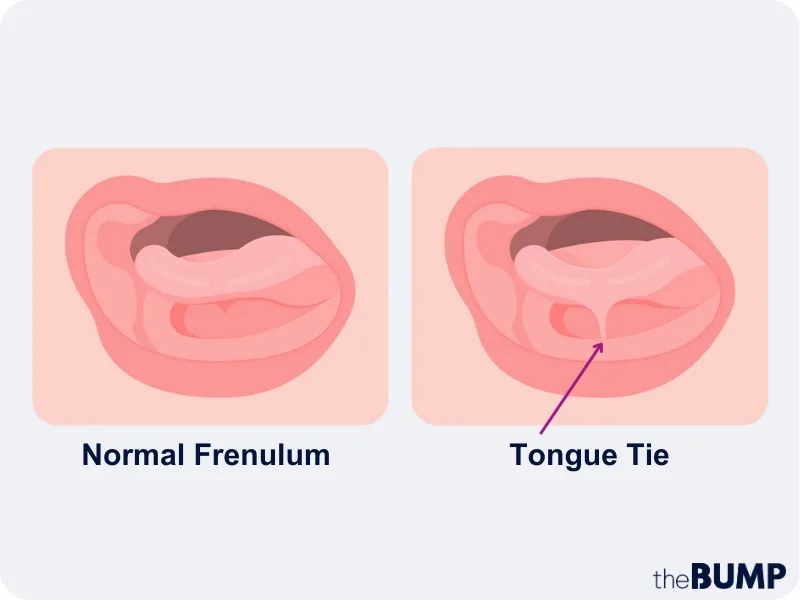What to Know About Infant Tongue Ties (and Should They Be Treated?)
You may have envisioned breastfeeding to be a blissful, beautiful experience—only to find yourself faced with the reality of cracked, bleeding nipples, a newborn who cries around the clock and a concerned doctor telling you baby has fallen below their birth weight. The truth is, breastfeeding can be an incredibly challenging experience for many reasons. One potential cause of breastfeeding problems: a newborn tongue-tie—a physical condition that can interfere with baby’s ability to feed.
While tongue ties can be surgically snipped, many experts believe they’re overdiagnosed and unnecessarily treated. So how can you tell if you truly have a tongue tied baby on your hands? Read on to learn from experts exactly what infant tongue tie is, how to know if it’s causing problems and when tongue tie surgery may be recommended.
Tongue tie—officially known as ankyloglossia (pronounced ang-kuh-loh-glaw-see-uh)—is one of the oral ties that can affect infants. It occurs when the tissue—called the lingual frenulum—that connects baby’s tongue to the mouth floor is so tight and thick that it restricts the tongue’s range of motion. Because the tongue can’t move freely, it may be hard for baby to properly latch onto a nipple or bottle, making it difficult to get enough milk or formula.
Some experts say there are two types of tongue ties: anterior tongue ties and posterior tongue ties. Anterior tongue ties are near baby’s gum line and by the tip of their tongue when they open their mouth, notes Cleveland Clinic. A posterior tongue tie may be further back on the tongue near the base, where the floor of the mouth meets the tongue. Both types of tongue ties may restrict movement.
What does a tongue tie look like?
“The band of tissue that causes tongue tie is thought to be an embryologic remnant of tissue that should have gone away during development of the fetus but never receded, and interferes with tongue function,” explains Denise Scott, MD, an Oklahoma-based pediatrician with over 25 years of experience. Tongue ties have a genetic component, adds Jocelyn M. Wood, a speech language pathologist with over 10 years of experience working with babies with lip and tongue ties. If you or your partner had one, your child might too. Similarly, if your first was a tongue-tied baby, your second might be as well. Wood also notes that tongue ties tend to occur more in boys than girls.
Tongue tie isn’t all that common but it’s not particularly rare; it likely affects somewhere between 4 and 10 percent of infants, according to research. But “because tongue ties are often not identified, it’s difficult to put a number on it,” Wood explains. “[Some] tongue tie professionals report numbers up to 25 percent.”
The reality is that it depends on who you ask—especially some pediatricians have raised concerns over them being over-diagnosed. (In December 2023, The New York Times published an expose on how tongue-tie clippings have become a lucrative business.) “It’s interesting that, despite a declining birth rate in this country, there has been a dramatic increase in this diagnosis and the treatment for it,” Scott says, referencing an article from Frontiers in Pediatrics. “Even more interesting is that this increase has been seen in the US, Canada and Australia, but not in other countries, such as Japan and Scandinavian countries, that have a higher incidence of breastfeeding.” Suffice it to say, there are some skeptics.
As Wood explains it, to breastfeed effectively, infants need to be able to cup their tongues around the nipple. “If the tissue under the tongue is restricted, this movement is difficult and may cause a weak latch,” she says. Baby may also struggle to sufficiently gain weight, adds Lauren Macaluso, MD, IBCLC, FAAP, whose practice focuses on breastfeeding parents. Plus, they may wind up taking in more air during feeds, leading to gas or reflux. Moreover, if they’re not getting enough milk, they may start to compensate by clamping down, which can be painful for Mom and lead to mastitis or other breast infections.
So can tongue-tied babies still breastfeed? It depends on how severe the tongue tie is. While a severe tongue tie in babies can lead to difficulty nursing, poor weight gain and painful breastfeeding, the vast majority of infants with tongue tie don’t have problems, says Scott.
Even if you peer into baby’s mouth and it looks like they have a thick or tight frenulum, that doesn’t necessarily mean your child will have difficulty feeding. For that reason, experts often rely on symptoms to assess whether a potentially tongue-tied baby needs treatment. So how can you tell if baby really has a tongue tie? While the thick frenulum can be plainly visible, you may need to rely on secondary factors for the real clues, says Leigh Anne O’Connor, IBCLC, a lactation consultant in New York City. Some possible signs of a problematic tongue tie to look for include:
- A heart-shaped tongue
- A tongue that can’t fully protrude
- A tongue that curls back on itself with attempted protrusion
- Increased gag reflex
- Difficulty lifting the tongue and swallowing
- Clicking noises when baby eats
- Painful nursing
- Cracked, bleeding nipples
- An infant who isn’t gaining weight or producing dirty diapers
While feeding problems can be indicative of baby tongue tie, it’s not the definitive cause by any means, O’Connor emphasizes. Many new moms initially struggle with breastfeeding for a variety of reasons, which is why it’s important to speak with your child’s pediatrician and a lactation consultant. “Pain with latching could be caused by poor positioning or other impacts,” Macaluso explains. “A mom may have physiological issues that cause latching problems, and in some instances, baby may be too relaxed to feed properly.”
Tongue tie is typically diagnosed by looking at baby’s case history and assessing their tongue function. “For infants, this involves watching the child feed and performing an assessment of the child’s ability to suck and move their tongue,” Wood says.
Many experts advocate for a wait-and-see approach. Even if the tongue tie persists, it doesn’t always interfere with feeding: “Sometimes, when the lower central teeth erupt, the band of tissue will tear on its own as an infant thrusts their tongue back and forth over the tooth surface,” Scott says. “Considering treatment during the first week or two of life is premature, except in severe cases.” Ultimately, if baby is gaining weight and breastfeeding is comfortable for Mom and baby, a tongue-tie surgery isn’t really necessary, O’Connell says.
Even if a newborn tongue tie isn’t causing feeding problems right off the bat, it could potentially create issues down the line. O’Connell occasionally sees infants who are 3 to 6 months old begin to have feeding issues due to tongue tie. “If a mom has a strong supply, the infant may not need to suck to get milk—the milk just lands in their mouth,” she explains. “But as the mom’s supply regulates, baby may not have an effective latch, and a procedure may need to be done.” There’s also the possibility of problems with speech later if the tongue tie is severe; there are cases when older children and adults need treatment, Scott says. However, she reiterates that most infants with tongue ties don’t have breastfeeding issues and won’t experience future related issues. To that end, she cautions against getting tongue-tie treatment to “prevent a possible future problem.”
Wondering if tongue ties will “release” naturally over time? The research is mixed. Mayo Clinic notes that the frenulum may loosen over time. However, some studies negate that claim.
Tongue-tie treatment generally involves a simple surgical procedure called a frenotomy. “This is where the tight band of tissue is snipped with sharp scissors… There has also been a recent trend in using a laser to treat,” Scott says. Usually the tongue-tie procedure is simple and doesn’t require anesthesia in babies. It’s often done in the hospital or a doctor’s office. That said, it’s not without any risk. “There can be complications such as moderate bleeding or the development of scar tissue….Potential infection or cyst development are other possible complications, but any of these are rare,” says Scott. The good news if you decide to pursue treatment? Baby will be able to nurse right away after surgery—and some moms–at least anecdotally—report immediate improvement.
It can be challenging as a parent to know who to listen to, especially when it comes to something as divisive as tongue ties. Scott recommends asking yourself: Will not doing the procedure be harmful—and will doing the procedure help? Trust your gut; talk to your pediatrician, a lactation consultant or a trained expert and don’t hesitate to get a second opinion.
Please note: The Bump and the materials and information it contains are not intended to, and do not constitute, medical or other health advice or diagnosis and should not be used as such. You should always consult with a qualified physician or health professional about your specific circumstances.
Plus, more from The Bump:
Lauren Macaluso, MD, IBCLC, FAAP, is a breastfeeding medicine and lactation specialist whose practice focuses on breastfeeding mothers. She earned her bachelor’s degree from Cornell University, her medical degree from Sidney Kimmel Medical College of Thomas Jefferson University in Philadelphia and completed her pediatric residency at Children’s National Medical Center of George Washington University in Washington, D.C.
Leigh Anne O’Connor, IBCLC, LCCE, is a board-certified lactation consultant based in New York City with over 20 years of experience. She has served on the Board of the New York Lactation Consultant Association and has been an accredited La Leche League Leader for over two decades. O’Connor is also a Lamaze Certified Childbirth Educator.
Denise Scott, MD, is a pediatrician with JustAnswer and a pediatric endocrinologist based in Oklahoma with over 30 years of experience. Certified in culinary medicine, Scott also runs the blog Feed Future Health and is the author of Feed Your Child's Future Health: Prevent Disease Before it Starts. She received her medical degree from the University of Texas Medical Branch and completed her residency at the University of Oklahoma Health Sciences Center, with a fellowship at the National Institutes of Health.
Jocelyn M. Wood, MA, CCC-SLP, is a New York City-based bilingual speech language pathologist with over a decade of experience. She specializes in working with parents who are seeking advice on how to introduce speech and language activities into everyday routines. She earned her master’s degree in speech and language pathology from Hofstra University in New York.
International Journal of Pediatric Otorhinolaryngology, The effects of office-based frenotomy for anterior and posterior ankyloglossia on breastfeeding, May 2013
Cleveland Clinic, Tongue-Tie (Ankyloglossia), July 2022
American Academy of Pediatric Dentistry, Policy on Management of the Frenulum in Pediatric Patients, 2022
Canadian Family Physician, Prevalence, diagnosis, and treatment of ankyloglossia, June 2007
The New York Times, Inside the Booming Business of Cutting Babies’ Tongues, December 2023
Frontiers in Pediatrics, What is tongue-tie and does it interfere with breast-feeding? – a brief review, April 2023
Mayo Clinic, Tongue-tie (ankyloglossia), May 2018
International Journal of Otorhinolaryngology, Understanding the Lingual Frenulum: Histological Structure, Tissue Composition, and Implications for Tongue Tie Surgery, June 2020
Learn how we ensure the accuracy of our content through our editorial and medical review process.
Navigate forward to interact with the calendar and select a date. Press the question mark key to get the keyboard shortcuts for changing dates.






















































